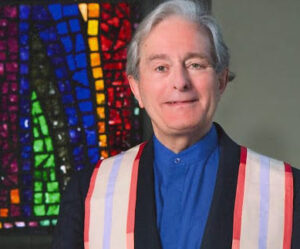Listen! Can you still hear the echo of our Easter Sunday “alleluias” and “Christ is risen. He is risen indeed”? As we journey through Eastertide, these ecstatic outbursts and responses may be growing fainter.
“Christ is Alive! Let Christians Sing” is a hymn by Brian Wren that moves us beyond singing of resurrection joy to the certain knowledge that Christ works daily in our lives.

Brian Wren
Wren is a British theologian, author and prolific hymnwriter who is a significant figure in the hymn renaissance begun in the 1960s. He was ordained in Britain’s United Reformed Church. He now lives in the United States and is professor emeritus of worship at Columbia Theological Seminary.
His seminal book What Language Shall I Borrow challenges the church to broaden its language in hymns and liturgy to include all and to widen the understanding of God through varied imagery. His hymns champion inclusive language and incorporate lively images of God (for example, “Bring Many Names“).
Wren wrote “Christ Is Alive! Let Christians Sing” for the Easter Sunday falling 10 days after the 1968 assassination of Martin Luther King. At that time, Wren was pastor at Hockley and Hawkwell Congregational (now United Reformed) Church in Essex. Compelled to write a text for his congregation that acknowledged the horrific event, Wren notes:
I tried to express an Easter hope out of that terrible event, in words which could be more widely applied, and wrote ‘Christ is alive!’ because our available hymns spoke of Easter as a glorious event long ago, far away, and high above.
Like many hymnwriters, Wren revises his texts. The text cited here is the third, and most recent, revision from 1995. The hymn’s five stanzas contain numerous poetic and literary devices that result in a vibrant text. Stanzas 1, 2 and 5 begin with the bold litany, “Christ is alive!”
Christ is alive! Stanza 1 invites Christians to sing praise to the Christus Victor. The alliteration, “drowned in death,” highlights the paradox of death never dying. Wren calls for our singing and praise to go from our sanctuaries into the world.
Christ is alive! Stanza 2 places Christ here and now, not a historical figure. When we sing Easter hymns such as “Christ the Lord Is Risen Today” or “Good Christians All Rejoice and Sing” or “That Easter Day with Joy Was Bright,” we rightfully focus on the joy of the resurrection event. Wren reminds us that we follow a cosmic Christ whose “saving, healing” transcends space and time.
“The words speak to the hope Christ brings to those now suffering because of divisions in ‘color, scorn or wealth’”
Stanza 3 is central to this hymn and speaks to the hope that Christ brings to those now enduring “insults, rifts and wars”: personal affronts, denominational fractures, societal divisions, war in Ukraine and other locales. The words speak to the hope Christ brings to those now suffering because of divisions in “color, scorn or wealth”: immigrants at our borders and victims of poverty, systemic racism and injustice. The Suffering Servant grieves, loves and lives in those desperate places and people where hope is dead.
Stanza 4 stands in stark relief to the previous verse with its exuberant promise that all women and men, young and old, can respond to the Spirit’s call and find the restoration revealed in Jesus.
Christ is alive! Stanza 5 points to the new creation in which earth and sky and ocean all participate in a joyful world of “justice, love and praise.”
Wren gifted the church with a text that is useful for Easter Sunday but is appropriate for worship throughout the year. Some of his turns of phrase in this hymn may stimulate our thinking: “drowned in death,” “no longer bound to distant years,” “where even hope has died.”
Wren has written many texts whose language or topics may startle or provoke people to ponder the gospel in new ways. Consider exploring some of his other hymns such as “A Prophet Woman Broke A Jar,” “God is One, Unique and Holy,” “Here A Man Hangs Discarded,” “I Come with Joy to Meet My Lord,” “May the Sending One Sing in You,” “There’s a Spirit in the Air,” and “Woman in the Night.”

Beverly Howard
Beverly A. Howard lives in Fort Worth, Texas. She is a retired university music professor, former editor of The Hymn: A Journal of Congregational Song, and member of hymnal committees that prepared Glory to God: The Presbyterian Hymnal and Celebrating Grace: Hymnal for Baptist Worship. She is a collaborating author for the forthcoming hymnology textbook Sing with Understanding: An Introduction to the Theology of Christian Congregational Song with Martin V. Clarke, Geoffrey Moore and C. Michael Hawn.
Related articles:
Hymn stories: Lord, Who Throughout These 40 Days


